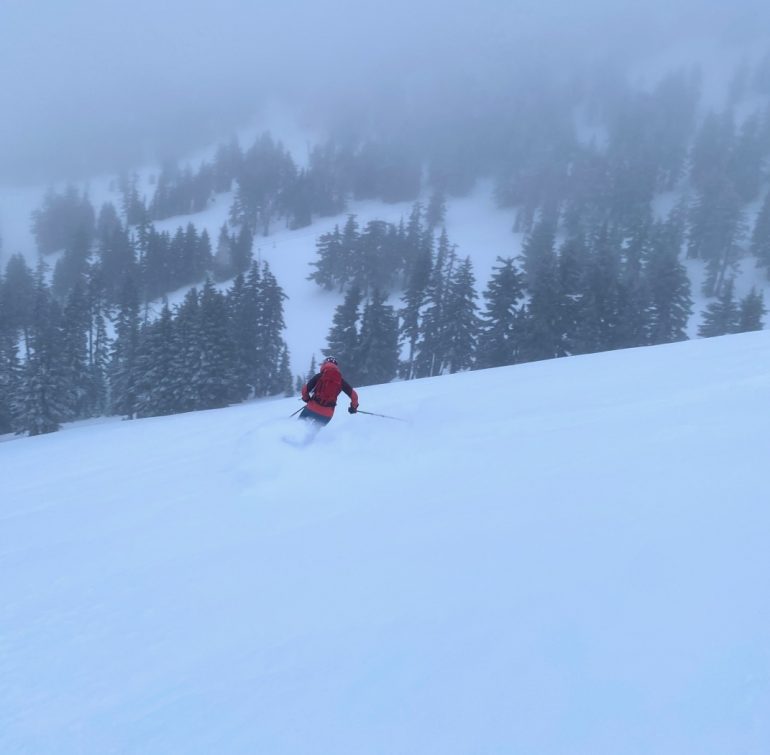
The Magico.2s held their own during our late December powder days.
The Pacific Northwest is not known for its powder. Sure, we get some big storm cycles and a cold powder day here and there (hello, final two weeks of 2021!)—and we get plenty of great skiing throughout every winter. Yet while we may not be known for having the best powder on Earth, we do get a lot of all the varieties of snow (and precip), which leads to a deep snowpack that consistently serves up spring corn from April through June: Volcano Season.
I love a good powder day, but the spring volcanoes are my favorite: from technical ski mountaineering, to adventurous traverses, link-ups or circumnavigations, descending 6,000’ of soul turns, and of course, multi-sporting–combining running or biking with volcano-skiing. To be candid, I’ll take skinny, lightweight skis, a big bag of snacks, and gobs of sunscreen over the deepest powder day (but only if I absolutely have to choose).
I’ve been on the same spring setup for several years—Black Crows Orb Freebird (90 mm underfoot, 1300 g) with Dynafit Speed Radical bindings—and they’ve been great. They’ve held their own in all varieties of spring conditions from the Selkirk mountains of BC, to the PNW volcanoes. Yet, I’ve been curious to try something different. I’ve got a few Black Crows setups in my ski quiver now—the Ferox Freebird (110 mm underfoot, 1600 g) as my midwinter all-conditions setup and the heavy-hitter Anima Birdie (115 mm underfoot, 2250 g) for staying afloat on the deepest days and plowing through variable snow—and while I’m a big fan, I’ve begun wondering what else is out there. I jumped at the opportunity to test out Ski Trab’s Magico.2.
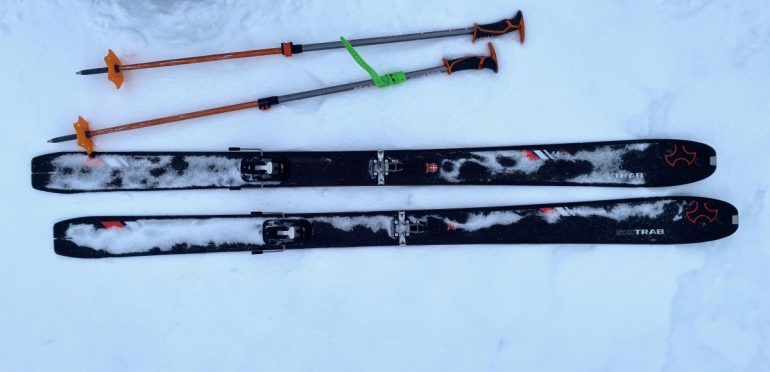
The Ski Trab Magico.2 ski is a lightweight ski (approx. 1000g) and 87mm underfoot in the tested length (164cm).
When I got my hands on these light-as-a-feather, 87-millimeter underfoot skis that just seemed to whisper let’s go ski volcanoes, I thought: “These are going to be fun”—but it was 9° F at the mountain and consistently dumping almost a foot per day. I knocked on my neighbor’s door to show them off to a fellow skier who’d appreciate a lightweight “volcano” ski, then put them in the garage and loaded my bulldozer 115-underfoot powder skis into the car. Sorry, magical new skis—spring volcano skiing was hard to imagine at the moment.
Fast forward to early January; winter dried up and disappeared for a few weeks. It was a time when everyone learned that the sun is still too low for a true corn cycle, but making the most of good coverage and a stretch of high pressure by finding some “spring-like” conditions up high was feasible. I reached for the Ski Trabs, and my powder skis took a turn on garage duty. In the past month, I’ve managed to get a handful of days on the Magico.2 skis, and we’re starting to become acquainted. Recently, I’ve discovered that these skis aren’t made just for perfect corn.
The Skis
This is my first time on Ski Trab skis, but among their website, product catalog, and reading what others have to say in online reviews, a few things are clear. First, the Magico.2 is an exceptionally lightweight ski designed for tours that are light and fast, long and technical, and everything in between. All things considered, that’s a big niche. Second, despite the low mass, they’re designed for the descent, promising powerful and precise turns in any conditions. Finally, the .2 version boasts an updated radius (increased from 17.8 to 21.1 for the 164 cm length) and improved float thanks to added rise, as well as a slightly longer and wider tip and tail than the original model (which, according to what I could dig up online, was very well received).
Tipping the scales at just 1032 grams (about 2.25 lbs per ski or 2.75 lbs when mounted with the Titan Vario.2 bindings), these are some of the lightest skis I’ve been on, with the exception of my skimo race skis, which of course have a specific application. Ski Trab describes the Magico.2’s design as using “14 layer control” technology constructed with a wood and aramid core. After studying the 14 layers in the manual that came with the skis, I understood that these skis are designed to be stable, torsionally stiff, and durable. Beyond that, I decided it doesn’t really matter what each layer means, as long as they are fun on the descent.
And that, they are.
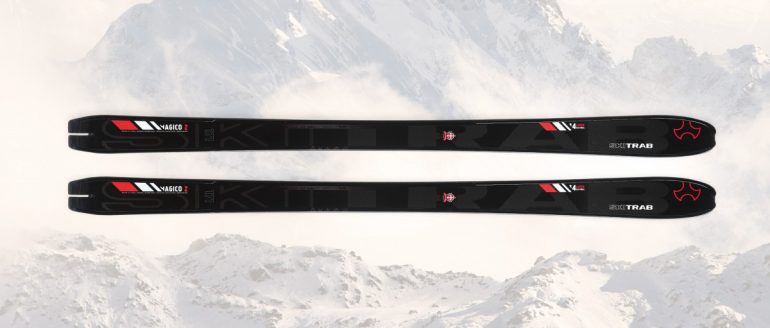
Behold the magic. Photo: Ski Trab.
My first day on the magical skis was on a soft but chopped-up groomer. I was feeling them out, keeping it fairly conservative, and I think I was a little too tentative. They skied fine, but I couldn’t get a good feel for them. They felt a little stiff. During the next few outings–on soft corduroy–I started to jive with these skis and open up a bit more. Then, I took them onto some crusty, variable terrain. I didn’t have high expectations, considering how light the skis are–and here, they pleasantly surprised me. They skied well through the crud. Finally, I got them out in a little fresh powder. Not deep enough to say whether they truly “float,” but enough to get a feel for how they perform off-piste in soft, fresh snow. Again, I was pleased with how well they stayed on top and made fast, floaty turns as well as any all-mountain ski I’ve ridden.
I am looking forward to continuing to push these skis into a wider variety of terrain and seeing what they can do.

The Magico.2s are mounted with Ski Trab’s Titan Vario.2 binding. An approx. 250g binding.
The Bindings
I’ve been a diehard Dynafit loyalist when it comes to bindings, but I’ve been becoming more open and curious toward other designs recently. So far, I’m enjoying the Titan Vario.2 bindings. They are super lightweight (less than 309g), intuitive to use, and have been performing well in my first handful of tours. Notably, the Vario’s titanium toe piece features independent jaws, which reduces the risk of an accidental pre-release (Though I’ve never pre-released in other tech bindings, I appreciate the added security). Like many lightweight tech bindings, the Vario can be set to flat for long approaches, which are common in Central Oregon, the high rise for steep terrain, or an in-between setting with a 8.7-degree angle. The rise angle ranges are: 0°, 8.7°, 10.5°.

A close up view of the Titan.2 toe piece. Unlike most tech bindings, the Titan.2s “jaws” are independent from one another. This is designed to increase retention.
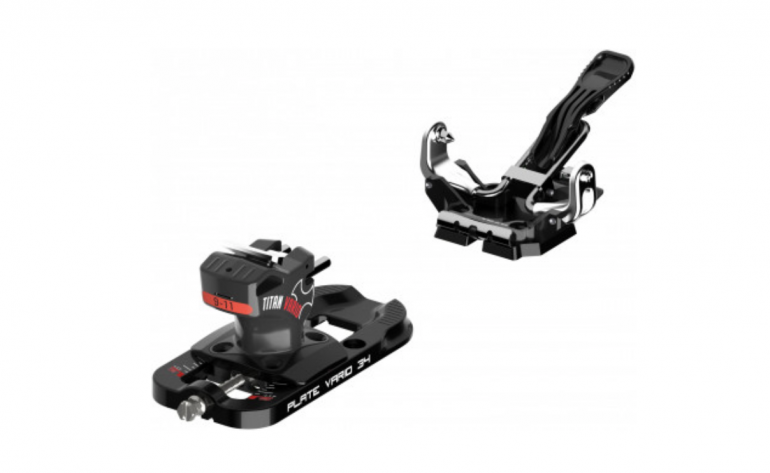
The heel piece features three riser options, a flat mode, and 24mm of adjustment. The spring range options for both verticle/horizontal release are 5-7, 7-9, or 9-11. These are fixed release levels.
With the mid-rise setting, transitions from ascent to descent are quick and easy. With a flip of the u-shaped piece on the heel unit, the brakes come up and the binding goes from downhill mode to uphill, with the mid-rise setting in place—a nice feature when I’m cranking out fast laps before work. The other travel modes (flat or high-rise) are accessible by twisting the heel piece (which rotates 360 degrees). I will be interested to see how this seemingly simple and intuitive binding holds up in more varied PNW weather conditions–when many bindings tend to ice up and fail.
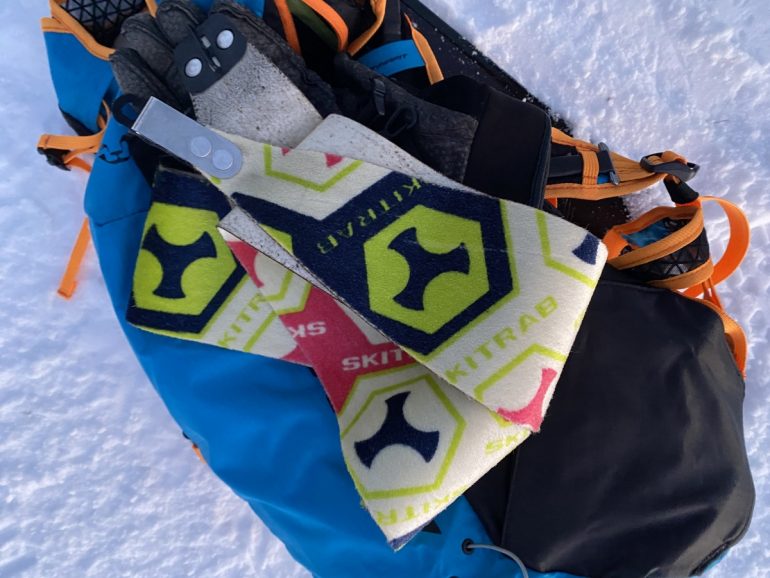
A clean and efficient pre-cut 100% mohair skin from Ski TraB.
The Skins
This setup came with Ski Trab branded 100% mohair skins pre-cut to fit the Magico.2 skis. They have a somewhat atypical attachment design, and I’m a fan. The skins attach with an “Attivo” (“active”) design that includes a hook with a pull tab around the tip, and a tab at the tail that inserts snugly into a notch at the end of the ski. The design allows the skier to rip skins from tail to tip or from tip to tail. Nice.
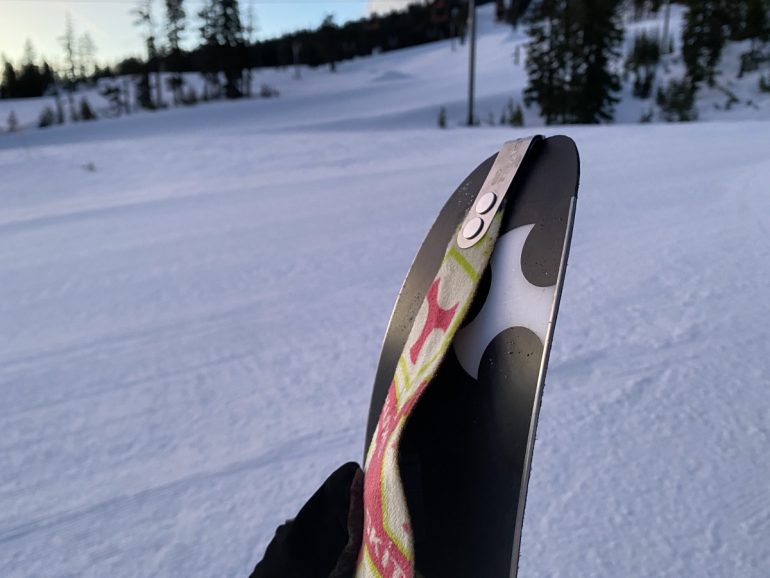
An secure tip attachment system flips over the tip and locks in place.

The tail securing system slots into the opening in the tail.
The mohair glides and grips well. The glue is pretty darn sticky at the moment–I’m hoping they’ll lose a little bit of that stick and become easier to rip as I break them in.
Conclusion
So far, so good with the Ski Trab Magico.2 skis, Titan Vario.2 bindings, and pre-cut mohair skins. I’m looking forward to putting some more days on these skis, getting to know them better, and taking them out onto our local volcanoes this spring. The question is, will they accompany me to Europe in late March? The coming weeks will help me decide.
The Basics
Price: $1100
Lengths (cm): 157, 164, 171, 178
Weight (gr): 1000, 1032, 1055, 1100
Dimensions: 118/88/104, 118/87/104, 118/85/104, 118/85/104
Turn Radius: 19.5, 20, 21, 23
Profile: slight tip and tail rocker, camber
Construction: 14 layer control with composite materials and stratification technology
Core: Aramid, ash wood, light wood
Skins
100% mohair with traditional hot melt adhesive system and Attivo tip and tail fasteners
Bindings
Weight (gr): 309
Material: Ergal, Titanium, Steel Technopolymer
Vertical release: Spring range options are 5-7, 7-9, or 9-11 (These are fixed release levels.)
Lateral release: Spring range options are 5-7, 7-9, or 9-11 (These are fixed release levels.)
Ski crampon compatible
Alli learned to ski as a wee grom in Central Pennsylvania before relocating to Oregon more than a decade ago, where she began venturing into the backcountry and up and down the Cascade volcanoes. Although she loves a good storm day, Alli lives for springtime volcano skiing. Alli is an AIARE Course Instructor and is currently an AMGA Apprentice Ski Guide. She lives and works in Bend, Oregon.
